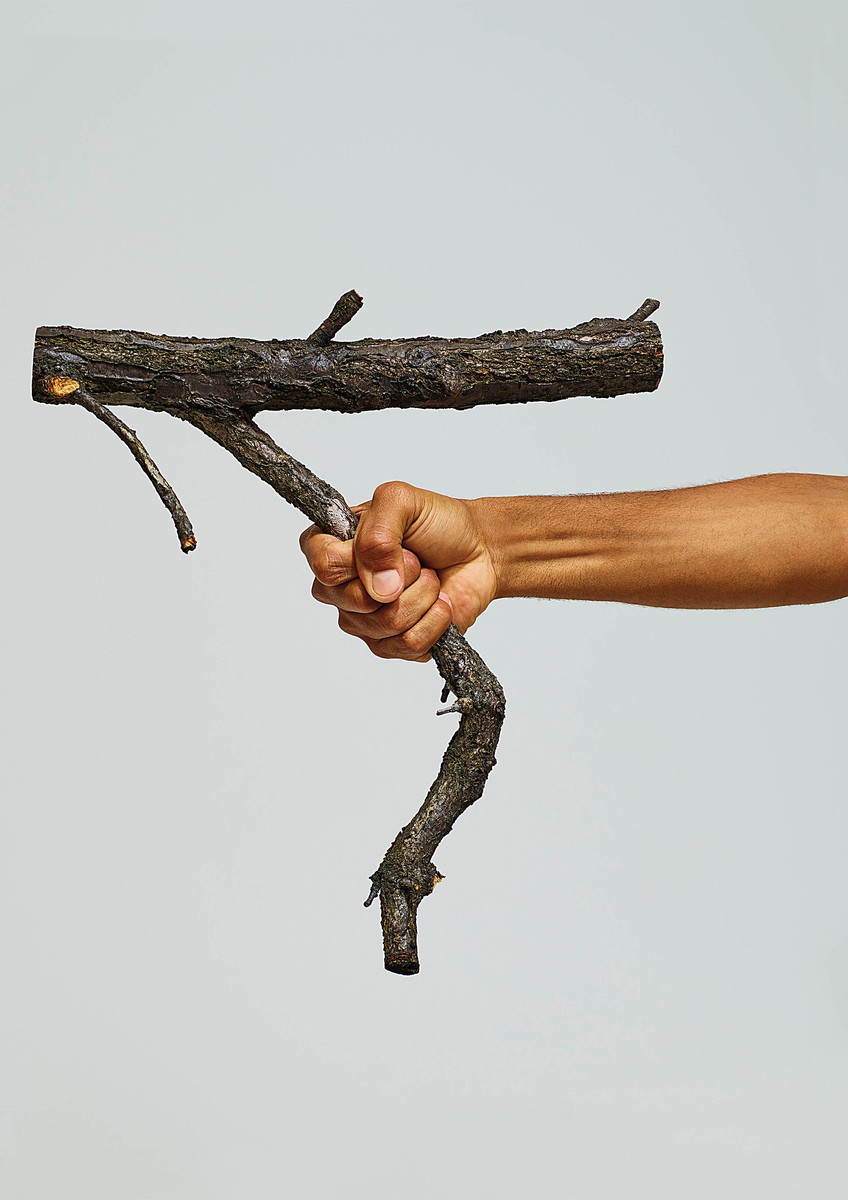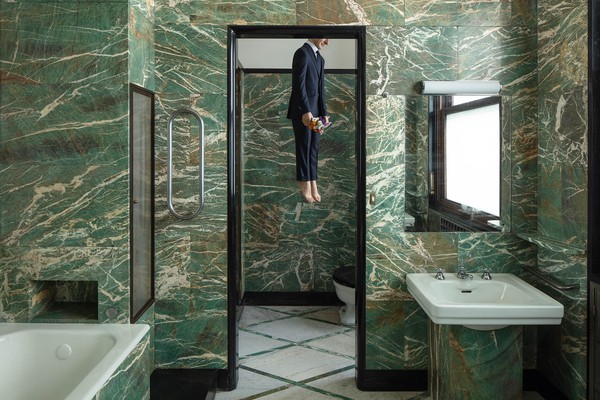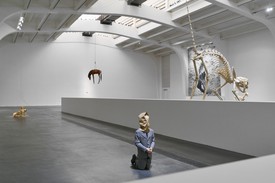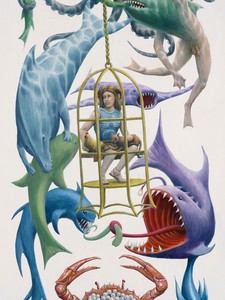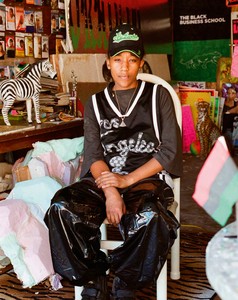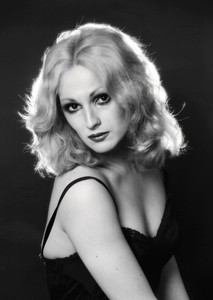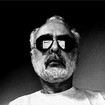
Francesco Bonami has curated more than one hundred exhibitions, among them the Venice Biennale in 2003 and the Whitney Biennial in 2010. He writes for Artnews and Vogue Italia. His most recent books include Bello, sembra un quadro. Controstoria dell’arte (Feltrinelli, 2022) and The Spinster’s Poem: 101 Bonaku, with a forward by Richard Prince (Karma Books, 2023).
Frank and Jamie (2002): it sounds like Abbott and Costello or Laurel and Hardy. Since it is actually a sculpture by Maurizio Cattelan, the simile isn’t strange, for people often find his work slapstick and funny. In fact nothing could be farther from the truth. Cattelan is a political artist at heart—not in the vein of Hans Haacke or Barbara Kruger but more like Aristotle, a sort of craftsman of social issues and ultimately of social and collective feeling. His political stance is not moralistic, accusatory, or preachy; he presents the issues as they are, or as a general public could perceive them.
Frank and Jamie are two policemen, leaning upside down against a wall. They were the first work Cattelan showed in New York after 9/11 and his last in any private space in the United States, in that case the Marian Goodman Gallery, until this spring. Far from being funny, the two figures are a symbol of power subverted—the Twin Towers in human form. The work shows how contemporary history, or its chronicle, influences our understanding of the world and our daily life: how we deal daily with power without running the risk of having our lives disrupted by it.
Cattelan doesn’t really seek answers. As Marcel Duchamp used to say, “There are no solutions because there are no problems.” There are no answers because there are no real questions—life is what it is, unraveling under our feet. In our delusional state, we might wish we could change it, but we can’t. After Frank and Jamie came the triumph of the retrospective at the Guggenheim, New York, in 2012, to be followed by America (2016), the gold toilet installed in the museum at the mercy of the visitors’ number ones and twos, according to the need. The natural heir of Duchamp’s 1917 Fountain, America made the cover of the New York Post, but the subtext was loaded: Donald Trump soon became president of the United States, making America rather more than a childish and expensive commentary on a world of luxury gone adrift.
While Cattelan’s infamous banana taped to the wall is called Comedian (2019), and a recent variation, a taped empty banana skin, is called Clown (2023), Cattelan is neither a comedian nor a clown but a combination of the two that produces a dramatic character, a kind of Robin Williams of art history, trapped in a body and fighting his true inner self. The result of this inner fight is a body of work that defies the conventional understanding of art, since it always refers to something outside the art world, even if art-world professionals can’t help but draw connections to other artists, from arte povera to Lucio Fontana. Such references are certainly possible, but are unintended and often serendipitous.
Besides being a closet political artist, Cattelan is also a bard of what I call “recreational violence,” or “RV.” Violence, like politics, is an intrinsic part of his language and philosophy, if often camouflaged under a veneer of humor. The new body of work is the logical expression of what was hidden in the too-obvious America: luxury and privilege can’t shield you from violence, articulated as some sort of ultimate entertainment, or the revenge of boredom and social resentment. You may be able to afford and enjoy making your daily number 2 on a solid-gold toilet, but that pleasure can’t save you from someone with an assault rifle coming into your bathroom to interrupt your bowel movement.
Seen from a distance, that could be very funny. Charlie Chaplin used to say, “Life is a tragedy when seen in close-up, but a comedy in long shot.” Cattelan similarly does a close-up, then a long shot, going in and out on reality. The last scene of Sam Peckinpah’s Wild Bunch (1969) may be enjoyable from a cinema seat, but the difference between the description of an action and the action itself can be dramatic and horrible. That gap between description and action, between entertainment and danger, is where Cattelan puts himself and the viewer. He and the viewer are in what we might call a Sunday state of mind, because Sunday is simultaneously a beautiful day and an ugly one, a holiday edging toward its own demise—edging toward Monday.
A gold panel covered with gunshot marks is like a Sunday: the background to a celebration gone bad, very bad. Shooting is not a novelty in art; we go from Manet’s The Execution of Emperor Maximilian (1867–69) to Goya’s Third of May 1808 (1814), from William Burroughs shooting everything and anybody around him to Chris Burden shooting at an airplane in flight, from Valerie Solanas’s attempt on the life of Andy Warhol in 1968 to Richard Avedon’s iconic photograph (1969) of the scars she left on Warhol’s body. But Cattelan’s Sunday (2024) goes a little farther, removing the presence of the shooter and transforming violence into a sort of pattern, a decoration, a memory of human folly. His wall could be the wall of some Las Vegas casino bullet-riddled by a disgruntled gambler. There is beauty in the aftermath of tragedy. The walls still standing from Beirut’s civil war look more like the ancient ruins of sandstone buildings than the rubble remaining from human insanity. Cattelan opens a way through this possible misunderstanding, speaking of the irresolvable contradictions between freedom and violence, fun and horror. Like a variation on Colonel Kurtz in the last scenes of Francis Ford Coppola’s Apocalypse Now (1979), Cattelan seems to murmur not “The horror, the horror” but “The fun, the fun.” Not that he dismisses the horror, but he sees the other side of it—the fun. Obviously not the fun of the victims but the unimaginable but definitely present fun in the mind of the mass shooter.
What continues to puzzle Cattelan is the way fun can again and again produce horror, as is shown by the endless series of tragedies perpetrated in the name of the fictional freedom to be able to defend yourself. To the extent that Cattelan’s large shot wall makes vague reference to Duchamp’s Large Glass (1915–23) in the Philadelphia Museum—the victim stripped bare, rather than the bride—it invokes the artist’s submission to fate, chance, and the inscrutability of real meaning. Since there is no real meaning in violence, it is pointless to seek it; yet when recreational violence is part of the daily routine, with disposable victims and disposable murders, another kind of silent violence seeps through the seams of the social pattern and Cattelan unjudgmentally dives into it, creating a parallel world to the spectacle presented by recreational violence.
In that world, Cattelan analyzes how human degradation and humiliation, consistently pursued, can achieve a sort of classical dignity, the dignity of human subjects erased by the social structure yet still breathing, like mummified corpses not yet dead. All of this appears in November (2024), a fountain recalling the Manneken Pis (1619), the street-corner sculpture of a pissing kid that has long been a landmark of Brussels. The difference is that what we see is not a playful child but a half-dozing male figure slouched on a bench with his penis in his hand, peeing on the ground. While it’s unclear whether the work is a monument to self-destruction or to survival, it certainly monumentalizes defiance of the written and unwritten laws of social and urban life; it is also another hymn to an awkward way of defining freedom. The male figure has no need of a gun to feel free or to avenge social injustice—his weapon is his own dick. He has no need to create horror, he is satisfied with inducing disgust. He dares you to take a selfie if you wish, and many will. In Cattelan’s work, repulsion, disgust, and violence are unavoidable backdrops to our detached and fictional lives. What’s the difference between a small child peeing in a fountain and a grown man peeing on the floor? It’s just a matter of convention. If you’re free to buy an assault rifle in a department store, what’s wrong with pissing in public? Sunday and November show an America gone adrift in the ocean of freedom while some kind of political hurricane is approaching.
Cattelan is shy of addressing these issues explicitly; his work does not directly respond to or comment on what’s happening. He’s like a Sunday painter setting his easel on the sidewalk, unaware that a murder will soon occur there, or maybe that two people will fall in love there, or that something else will happen, including maybe nothing. He is a Sunday painter. His job is to paint, without judging it, whatever will happen that Sunday, on that sidewalk, at that time.
Maurizio Cattelan: Sunday | Curated by Francesco Bonami, Gagosian, West 21st Street, New York, April 30–June 15, 2024
Artwork © Maurizio Cattelan
